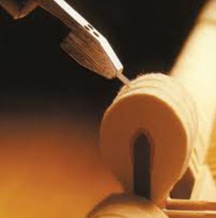 I had the full intention of writing a blog on piano voicing and then suddenly realized that there are 3 completely valid meanings to piano voicing. The first meaning of voicing refers to chord voicing which denotes how you spread out the notes of a chord on the piano (quite often in the jazz idiom). The second meaning, as it refers to piano playing and pedagogy means making the melody line stand above the accompaniment. You voice the melody to be more audible than the rest of the notes you’re playing. The third definition however, refers to the technical aspect of manipulating the tone of the piano. It is this subject I’d like to delve into a little deeper.
I had the full intention of writing a blog on piano voicing and then suddenly realized that there are 3 completely valid meanings to piano voicing. The first meaning of voicing refers to chord voicing which denotes how you spread out the notes of a chord on the piano (quite often in the jazz idiom). The second meaning, as it refers to piano playing and pedagogy means making the melody line stand above the accompaniment. You voice the melody to be more audible than the rest of the notes you’re playing. The third definition however, refers to the technical aspect of manipulating the tone of the piano. It is this subject I’d like to delve into a little deeper.
When I was young I was slightly misguided in thinking that every piano brand had a signature sound. While there is truth in that statement, pianos can sound vastly different from model to model and can vary from even piano to piano. Why? At the core, the piano is comprised of natural products such as wood, felt, steel, leather and iron. All of these raw materials have anomalies and subsequently, no 2 pianos are the same. So while it is true that there are inherent qualities of tone related to a brand, the subtleties vary significantly from piano to piano. Voicing serves 2 purposes: one is to alter and change the global sound of a piano and two, to make a piano sound even.
What does it mean to have “even” tone? When I was 13, my piano teacher asked me to play a scale. “Play it like a string of pearls ~ matched in color and size. If you want to get louder, do so by tapering each note a little louder, then a little softer. Do everything gradually.” It was an idea that I could visualize where each pearl had its own quality and it was up to me as a performer to use some sense of skill to match one note on the piano to the neighbouring note. She taught me a lot about making simple technique musical. And when you play notes on the piano evenly in succession, it tricks our ears into thinking it’s monophonic (meaning “one sound” like the human voice).
At times, however, I’ll be playing what I believe to be consistently when all of a sudden, one note sounds different than the rest. Playing the note in isolation, it becomes apparent that this one note sounds sharper or “brassy”, bright or strident while the neighbouring notes sound warmer, mellower or darker. These are common words many people use to describe the tone of a piano. In short, the fix for the protruding note is called piano voicing. Piano voicing involves manipulating the instrument to achieve a different audible result. To create an even performance at the piano, it must be voiced so that each note sounds similar to its neighbours, making transitions in a musical line seamless. When I was in Hailun and Petrof factories last year, I took some time to watch factory workers whose jobs are solely voicing and tuning. It takes a trained ear and substantial skill to play notes quickly in succession and level the audible high spots which are strident and bring up the low notes to match the others.
So how does this process happen? How does one change the sound of a piano? To answer that, we need to think of what parts can be altered readily on a piano? Voicing predominantly involves altering the strike point of the hammer as it touches the strings. Yes, it could involve many other procedures but voicing is more commonly referred to as an immediate alteration to the wool hammers to produce a different tone. As to how this art of voicing happens, preparation precedes practice.
Tuning
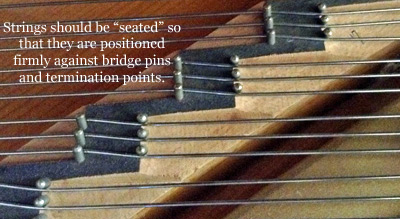 Pianos must first be in tune. How do you listen to the nuances of tone if the strings are not in unison? When you look inside a piano, 2/3rds of the notes have 3 strings per note. See our recent blog entitled How Often Should I Tune My Piano for a full description of the strings inside a piano. If there are 3 strings on a single note and they each are resonating at different frequencies, it’s like having 3 people talking at the same time. It’s impossible to hear the tonal quality of a note when all of the strings are not resounding in unison. So the first step leading to voicing is tuning. It is also during this time that most piano technicians make mental notes of the “worst offenders” which are anomalies across the keyboard. Because tuning takes well over an hour to get it in shape, familiarity with the piano also happens during this time. It takes time with a piano to find out what sounds it produces ~ what are its strengths and weaknesses and what areas need addressing more than others.
Pianos must first be in tune. How do you listen to the nuances of tone if the strings are not in unison? When you look inside a piano, 2/3rds of the notes have 3 strings per note. See our recent blog entitled How Often Should I Tune My Piano for a full description of the strings inside a piano. If there are 3 strings on a single note and they each are resonating at different frequencies, it’s like having 3 people talking at the same time. It’s impossible to hear the tonal quality of a note when all of the strings are not resounding in unison. So the first step leading to voicing is tuning. It is also during this time that most piano technicians make mental notes of the “worst offenders” which are anomalies across the keyboard. Because tuning takes well over an hour to get it in shape, familiarity with the piano also happens during this time. It takes time with a piano to find out what sounds it produces ~ what are its strengths and weaknesses and what areas need addressing more than others.
Levelling the playing field
Seating: At times, some notes will give off distortion. A trained technician will know that this is sometimes caused from the string not sitting flush up against termination points. Moving the string slightly can alter a note drastically.
Centering: Over time, some hammers shift from their strike position and don’t hit the all of the strings squarely. Adjusting the hammers to be striking in the center of the felt and at the same time is extremely important to consistent tone.
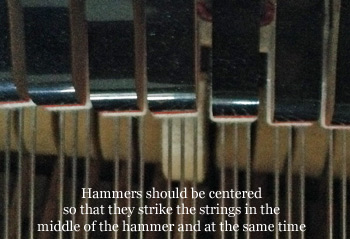 Travel refers to the movement of the hammer up towards the string. If the hammer is on an incorrect trajectory towards the string, it will hit the strings at more of an angle and also create odd tones or have one string strike before the other two. “Squaring” the hammers ensures they strike in the correct position at the same time.
Travel refers to the movement of the hammer up towards the string. If the hammer is on an incorrect trajectory towards the string, it will hit the strings at more of an angle and also create odd tones or have one string strike before the other two. “Squaring” the hammers ensures they strike in the correct position at the same time.
Surface Preparation: If grooves in the hammers are significant, filing the felt of the hammers should be done to regain proper surface contact.
Action Corrections: Sometimes one note will be misbehaving mechanically and render it powerless. In such cases, it tricks our ears into thinking it has a different tone when in fact, there’s a mechanical problem. There are many issues that can arise in a piano that lead us to believe individual notes need voicing when in fact they require mechanical fixes or adjustments.
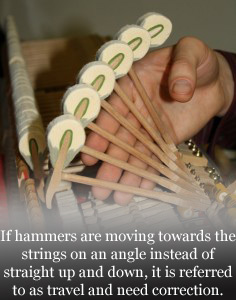 With the aforementioned areas addressed, voicing can now commence. Please note: these are piano BASICS. Pianos are much more involved but for the purpose of describing piano voicing, these are the baselines which all pianos must adhere to. These are the practical fundamentals of most household instruments and not concert level pianos which can sometimes take days to tweak.
With the aforementioned areas addressed, voicing can now commence. Please note: these are piano BASICS. Pianos are much more involved but for the purpose of describing piano voicing, these are the baselines which all pianos must adhere to. These are the practical fundamentals of most household instruments and not concert level pianos which can sometimes take days to tweak.
Voicing
So let me ask, what kind of tone do you wish to have coming from your piano? Beauty, after all, is in the eye of the beholder. Some wish for a power piano – strong and bright. Others want soft and felty. Personally, I look for versatility in a piano. I prefer pianos to be intimate and warm at softer dynamic levels and have a crossover where they can shift into more strident sounds when playing with force. Pianos that are icy cold or brittle at softer volumes I find somehow less satisfying and difficult to express emotionally. Conversely, playing powerful music with a dull thud also feels like it is somehow lacking.
Let’s be clear, however that piano voicing has limitations. I’ve often said that 50% of the tone of a piano is inherent to the instrument. It’s the wood ~ the soundboard, the bridges, it’s the design ~ the scale, the placement and thickness of the soundboard, the amount of ribs, backposts, rim construction etc., it’s the action ~ how it translates our musical intention into sound – all of these elements make up the piano. These I would mainly consider non-negotiable. Yes you can start down the path of reconstructing parts but this is more major surgery. The other 50% can be altered somewhat depending on the quality of the piano and the results vary drastically. Piano hammers also have a shelf life as well. Really old and “dead” sounding hammers fibers, ones that are really grooved, hardened or lifeless sounding need replacement.
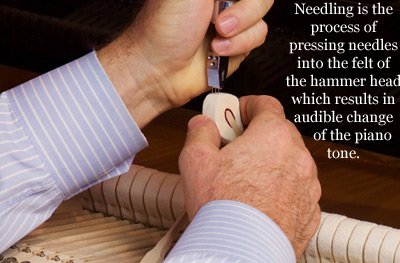 Needling
Needling
Most pianos with time and playing become more brittle and harsh. The majority of the requests for voicing involve making pianos softer with fuller body. When I was young, I sought the brassy power piano. As I age, I look for tonal color more akin to “autumn leaves” ~ colourful, warm and beautiful. We get used to the piano we play and don’t consider that alterations could make the experience more enjoyable. With harsher tones, piano hammers can be “needled” in various locations to achieve those results. A needling tool simply has needles that get inserted into the piano hammer. Since piano hammers consist of felt stretched and glued around a wooden hammer molding, the insertion of the needle “fluffs” hammer felt, making it not so compacted. In other areas of the hammer head, the needle acts to give greater body or sustain. Most piano technicians know how to needle to create the desired effect.
Chemical Solutions
Solutions for both hardening and softening also exist. A hardener coats the hammer and creates more brilliance in tone. Softeners penetrate and relax fibers and create softer sounds. While there are those who disagree with putting anything on the hammers, I believe that there is a place for more drastic alterations of hammers that have desirable end results. The danger is that solutions can be added to a hammer but cannot be extracted. I’ve actually played pianos rendered unplayable due to excessive chemical applications. The recourse really is only to change the hammers. But I’ve also played many pianos that have been strategically voiced with solutions for incredible results. The word here is caution and work with a piano technician you trust. Ideally, I like the felt of the hammer to speak. If you’re looking for a certain sound, sometimes changing the hammer is a better way than to try and artificially transform a piano into something it wasn’t intended to be.
Pianos are dynamic in nature. They are constantly changing. Voicing is not a do-once application but rather a process with time and maintenance. It involves keeping the piano at its best throughout its life-span. Have you lost the love of your piano? Sometimes pianos simply need to be voiced to bring it back to more of the sound when you first acquired it. You’ll be amazed at the results. Piano maintenance is so much more than tuning. Once you realize the possibilities, you’ll be amazed at how musical and beautiful your piano can be. Click HERE for a list of piano technicians in your area.
More Piano Articles

You’ve been playing your piano for years now and the time has come to seriously consider downsizing the house and move into a condo. But what do you do with the piano? You love your piano and can’t imagine life without it and besides, you absolutely hate the idea of playing a digital keyboard. Many people don’t know that you can add digital functionality without compromising your existing piano. Yes, it is completely possible to ...
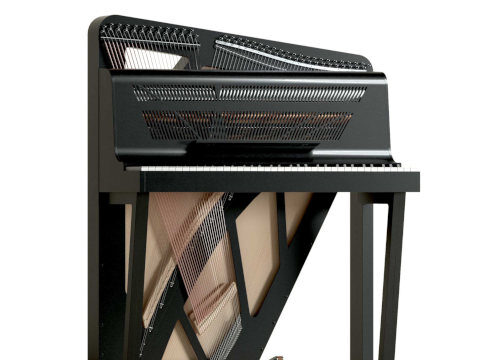
Many years ago, I remember seeing a piano in a museum similar to the one shown above (built in 1787 by Christian Gottlob Hubert. On display at Germanisches Nationalmuseum - Nuremberg, Germany). I have often wondered why acoustic portable pianos never really took off. Although we've seen more portable keyboard instruments like harpsichords, accordions or electronic keyboards, they operate completely different from a traditional piano in that they either pluck the strings, use air with ...
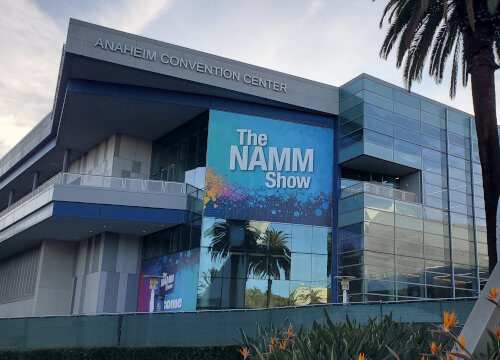
This was the first year since covid that the National Association of Music Merchants (NAMM) trade show was back to its regular January date and, in fact the first show where it felt back to normal. How was it? To answer that, I'm going quickly review the piano market over the last few years. Piano sales boomed during covid. Think about it - everyone was at home and with time on their hands, many turned ...
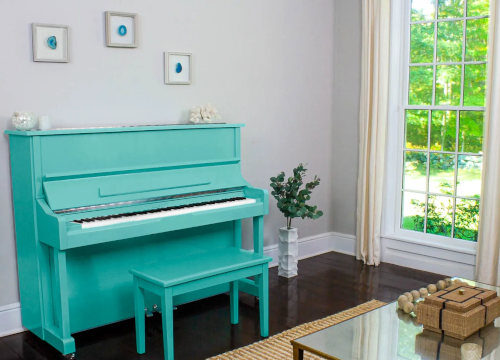
I’ve often wondered when the business model of piano buying would start to change. It seems like we feel comfortable purchasing everything from toothpaste to tires online and yet pianos are one thing that you still buy in a store. Well some of that is about to change. After speaking with Larry Caruso from Caruso Piano, they’re launching a brand of piano made specifically for online ordering. It’s called
Sonnova. I recently had the pleasure ...
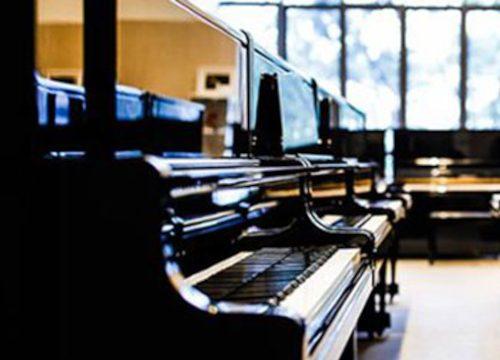
The thought of buying a piano can be exciting but it can also be a bit intimidating or daunting, especially if you don’t know anything about them. But have no fear, because at Piano Price Point, we’ve compiled so much of the data and written articles to make your job easier. To narrow down the scope of buying a piano, you first need to decide what kind of piano you’re looking for. Ask yourself these ...
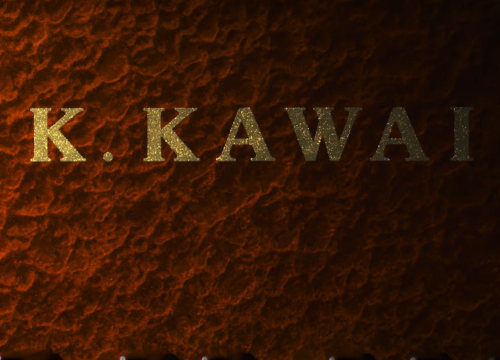
Money, apparently
does grow on trees or at least in ancient times it did. It's been recorded that rare tree sap was used as a form of payment for tax because it was deemed so valuable. This sap from the tree was harvested and refined into lacquer with incredible clarity and sheen. Many thousands of years ago, it was reserved for imperial palaces, religious temples and shrines. Early
examples have been dated to 7000BC. It ...